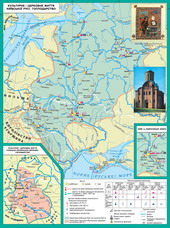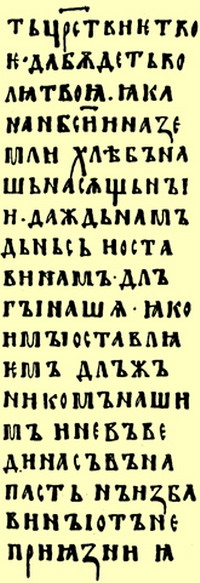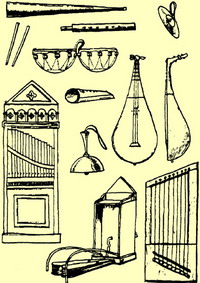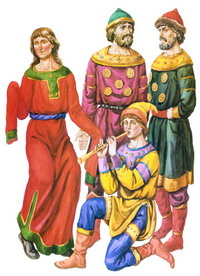Writing, education, scientific knowledge, literature and music of Kievan Rus and Galicia-Volyn state
Plan presentation
- development of Ukrainian language.
- spread literacy.
- Education.
- development literature.
- Natural and mathematical knowledge.
- musical creativity.
Timeline
|
1056-1057 he |
Create Ostromirov Gospel - the first dated manuscript Russia. |
|
1073 |
Creation "History Computerization Sviatoslav». |
|
1113 |
Conclusion Nestor first edition of "The Tale of Bygone Years». |
|
1187 |
Creation of "The Tale of Igor's». |
basic concepts and terms
Bible or Scripture - books written by the Spirit of God sanctified by God through men called prophets and apostles. In the Bible God's revelation came to us accurately and consistently. Books written before Christ, united in the Old Testament, after Christmas - in the New Testament.
chronicle called historical literary work in which the most important events recorded in chronological order by year (in years) - "Summer in the summer," as said by that time.
Persons
Nestor. Since 1074 - monk of Kiev-Pechersk Monastery. It is considered the author and compiler of "Tale of Bygone Years" (c. 1113 -1114 biennium).
Alipio Caves - Kyiv iconographer, a monk of Kiev-Pechersk Monastery. According to the Kiev-Pechersk Patericon of 1084 participated in the painting of the Assumption Cathedral in Kiev-Pechersk Lavra.
Anthony Caves - Kievan Rus church figure, one of the founders of Kiev-Pechersk Monastery. After returning he settled with Hilarion, the future metropolitan of Kyiv, near the summer residence of the dukes Berestova village on a hill overlooking the Dnieper (according to other data - in a cave dug Hilarion). At this point there was the Kiev-Pechersk monastery, whose founders are Anthony and Theodosius.
Agapit Caves - one of the first monks Caves, the most famous doctor XI. It is known that he was tonsured Antoniy. Prayer and healing herbs.
Hilarion - church leader and writer of 11 century. First Metropolitan of Rus' (from 1051). There was a priest at Brest, near Kyiv. Author church and theological work "Discourse Concerning Law and Grace", written between 1037 and 1050
Theodosius Caves - prominent church figure of Kievan Rus, abbot of the Kiev-Pechersk monastery, writer. 1055 was passed to Anthony Caves Monastery. Around 1062 a celibate priest, and later - Abbot Kiev-Pechersk Monastery. Theodosius began construction of the Assumption Cathedral and monastery cells. He took an active part in the political events that took place in Kiev in state 1060-70's, during the struggle between Kyiv table Yaroslavych.
main presentation
1. The development of Ukrainian language
- origins of the Ukrainian people date back to Old Slavic, yet peredderzhavnyh times.
- Then, according to scientists, was formed the Ukrainian language, since becoming a separate nation and its language development occurs simultaneously.
At 9-13 - century. in our language has already happened many features that distinguish it from other Slavic languages.
- It is different from modern. This is why the history of those times, the researchers used the term preUkrainian language.
Writing
-

 Language Researchers say that in the second half of September - early 10 th century. our ancestors existed writing .
Language Researchers say that in the second half of September - early 10 th century. our ancestors existed writing .
He - ancient alphabet was based on the Greek - and this is not surprising given the long-standing ties with the Eastern Slavs Greeks in Byzantium, which the young Rus state had the closest relations, the national language was also Greek.
- proof of the existence of its own original alphabets in the ancient Ukrainian is finding marks on the walls of the cathedral.
- Kyiv scribe in 11 century. issuing carefully on the walls just built the house the alphabet, which differed from the common at the time Cyrillic, established for the transfer in writing of one of South Slavic languages using Greek letters brothers Cyril and Methodius and adjourned on our territories with the adoption of Christianity.
- Using the adoption of Christianity in our land and spread Oldslav, or starobolharska literary language - the language of the Orthodox Church.
-
 significantly differs from narodnorozmovnoyi language, she still had something in common with her, because based on close, too Slavic language, and so was understandable, especially educated people - clergy, princes and boyars.
significantly differs from narodnorozmovnoyi language, she still had something in common with her, because based on close, too Slavic language, and so was understandable, especially educated people - clergy, princes and boyars.
- Scientists say that Kyivska Rus existed two options written literary language: Church Slavonic, which were written the most important liturgical books, and Church Slavonic with large blotches of living language (for a later time it is called Middle Ukrainian portrait ) - wrote her various writings and literary works of secular trend.
- However, both written language significantly different from the time living the Ukrainian language used in speaking.
- But it was not only in the Ruthenian lands, but everywhere in Europe, where literary (portrait) language for many people was Latin.
2. Distribution of Literature
Book Attractions
- In our time from the days of Kievan Rus and Galicia-Volyn principality remained very few books.
-
 oldest among them is Reims Gospel Ostromyrov Gospel, « ; History Computerization Sviatoslav » 1073 and « History Computerization » 1076, and Mstislav's Gospel.
oldest among them is Reims Gospel Ostromyrov Gospel, « ; History Computerization Sviatoslav » 1073 and « History Computerization » 1076, and Mstislav's Gospel.
- This list is headed by famed Reims Gospel , which was brought to France the daughter of Yaroslav the Wise, Anna.
Scientists - date of 40 years, we 11 century.
His name - Reims Gospel owes city Reims in France, where it remains today, although it created Kiev scribes - especially for the princely family.
- oldest dated monument portrait of Russia is Ostromyrov Gospel .
- created this book in Kiev 1056-1057 biennium, as evidenced by the special account.
- Ostromyrov Gospel - a monument of exceptional artistic value.
- Among the earliest books, preserved to this day, there are those that are meant for secular reading. It is about « History Computerization » - collection of various works of Greek authors theological and edifying content, most of which clarifies complex areas where the Bible , is, so to speak, a kind of encyclopedic listings.
They survived two - - 1073 and 1076 First name keeps them ' I of the Grand Prince Svyatoslav Yaroslavych, though, as noted researchers, commissioned the book, his brother - Prince Izyaslav.
- «History Computerization Sviatoslav» sumptuously ornamented miniatures, miniatures and numerous initials.
- «History Computerization » in 1076 finished much more modest, though not inferior care first scribe.
From the book - monuments of the 12 century. most famous Mstislav Gospel , rewritten about 1115
- Mstislav Gospel was written in order to Kiev Mstislav Vladimirovich, son of Grand Duke of Kiev Vladimir Monomakh.
- few books monuments preserved from the Kievan Rus' and Galicia-Volyn principality, are rare pearls from the vast riches of the book that it was our land.
- According to scientists in 13 century. in Russia was to be 130 - 140 thousand several hundred titles of books, because it required so many churches and monasteries - centers of the main book-learning.
- According to researchers, only in Sofia there were depositories to 950 handwritten books.
- Many books have been rewritten i created in Galicia-Volynskiy state. Great knyhopysna shop existed, particularly when Prince Vladimir dvori Vasylkovych
3. Education
- literate in princely times were not only officials and media people from the clergy, but also craftsmen and ordinary warriors.
- Care about education since the introduction of Christianity took over the state and church.
- Under the reign of Vladimir in Kiev Svyatoslavich already existed a school for teaching children with inner circle of the Prince.
- In 1086 a grandson of Yaroslav the Wise Janko Vsevolodovna founded the monastery in Kiev Andrews school for women.
- Finds Berestiany letters, bronze and bone wrote argue that literary science developed not only in the capital city, but in different parts of the country.
- example, Berestiany letters found in Zvenyhorodi and Brest, bronze was writing for writing on wax tablets - in Zvenyhorodi, Peremyshli, Halychi, jail.
4. Development of Literature
Folklore
- Even before the emergence of writing in the eastern Slavs existed rich oral folk arts: ritual songs, legends, riddles, legends, spells, epic and lyrical songs.
- from Kievan Rus' and Galicia-Volyn principality us diyshly legends and tales, druzhynni, holidays, wedding songs, fairy tales, carols, prysliv'ya, prypovidky, spells and charms mahichni.
- a monument of the Old Rus creativity were Bylina .
- oldest, the largest volume i nayvartisnishymy in artistic and historic aspects considered Bylina Kiev, Volodymyr or cycle.
- ISSN they are related USED capital city of Kyiv Prince Volodymyr i his Red Sun.
- Bylina Kiev cycle consisted of 10-11 centuries. They ospivuyut muzhnist i horobrist bohatyriv who defended samoviddano native land from vorohiv.
- In the 13-14 centuries. Bylina filled with new subjects related to the particular realities of Galicia-Volyn state: Prince of Romance, Michael Kozaryna and others.
translated literary heritage
- Beginnings of literary life in our region, except usnopoetychnoyi work, had another source - the literary works of other people who, because of Church Slavonic translations came after the introduction of Christianity.
- From Rus lands are part of the Christian world to our ancestors opened the richest treasury of human experience and wisdom - Bible.
- Opportunely note that translation of the Bible not only had an invaluable impact on the people of that period, but also contributed to verbal creativity, since the Bible - an inexhaustible source of eternal themes, ideas, images.
- In the Bible, translated and Apocrypha - works on biblical subjects, who for various reasons were not recognized by the church.
- Another popular genre of literature were translated lives of - the story of the life and deeds of the saints.
- translated books, and secular trend. Especially popular in Russia was a collection of cruise expressions and proverbs from the Bible and the works of ancient writers "Pchola.
- very popular chronicles of Byzantine historians George and John Amartola Malalas, many plots of which the Russians used the chroniclers, speaking in his writings on the fundamental principle of humanity, the most ancient peoples and the state.
Original Literature
-
 original, that is proper, original literary works of our ancestors by the Kievan Rus was established chronicles .
original, that is proper, original literary works of our ancestors by the Kievan Rus was established chronicles .
- first chronicle, which came to us, is «Tale of Bygone Years».
- him at the start of the 12 century. When skladanni "Tale of Bygone Lit" used the ancient chronicles.
- «Povist ..." remains in many lists.
- oldest of them - Lavrentiyivskyy (1377) and Ipatiyivskyy (first half of 15 century.).
- In "stories ..." described events from 860 to 1111
- one of the above lists that chronicle the construction kept the name of the author-compiler - a monk of Kiev-Pechersk monastery Nestor.
- in continued "stories ..." is litopys Kyiv , which covered the time from 1111 to 1200
- He talks about the events in the lands of Kievan Rus different, but in the middle story - i Kiev Kyiv land.
- main content Chronicle - Kyiv prince fighting for a table, the fight against Rus Polovtsian.
- flagship landmark chronicle of Galicia-Volyn state is Galicia-Volyn chronicle .
- Litopys consists of two parts. In the first talk about the events in Halytskiy land from 1205 to the end of the 50's of the 13 century.
- It is actually a biography of Prince Daniel Romanovich .
- second part of the Galicia-Volyn Volyn litopysu connected with the earth and the Prince of Volyn.
- Among other genres of original literature should mention church sermon .
- Nayvyznachnishym author instructive sermons was one of the founders of Kiev-Pechersk monastery Feodosia Caves.
- Urochysti Sermons were composed for osvichenyh people - knyaziv, boyars and clergy.
- excellent example is the opening Sermons « word about the law of grace i » Metropolitan Ilariona .
In the records - Lavrentiyivskoho list during 1096 vmischeno memo, known under the name «Instructions Vladimir Monomakh .
- «Instructions" directed to children Monomakh.
- the conviction Monomakh prince gives her an example to children vzirtsevoho ruler teaches hidniy this high rank povedintsi and lifestyle.
- most remarkable monuments of the Ruthenian literature is «Tale Ihorevim».
- long time, this gem of ancient literature was missing: it accidentally found in the early 90's of 18 century. in one of the 16 th century manuscripts.
- «Word ..." written on the basis of a concrete historical fact - a failed raid in 1185 Novgorod Prince Igor Seversky Svyatoslavich against Polovtsian.
- According to researchers, "... the word" created with fresh traces of events - sometimes in August - September 1187
- author of the poem could be the eldest son of Prince Yaroslav the Galician Osmomysl, Homeland brother Igor's wife Yaroslavna Prince Vladimir.
- One of the most popular books in Russia was «Kiev-Pechersk Paterikon» .
- He concluded in the early 13 century. monks of Lavra, who sought to emphasize the critical role of his monastery, to substantiate its superiority among others.
- From the book we learn about the history of Kiev-Pechersk monastery, its first devotees, including the founders of the monastery of St. Anthony and Theodosius, artist Alypius.
5. Natural and mathematical knowledge
- The level of contemporary natural and mathematical knowledge to some extent indicates the popularity of Ruthenian lands translated books such as "Shestydnevy", "physiologist", "Heaven", etc., in which medieval thinkers set out ideas on the structure of the world.
- Yes, "Shestydnevy" revealing the history of the world by God in six days, while not referring only to the Bible, but also the work of the ancient sages.
- In "physiologist" contained stories about real animals (lion, eagle, snake, hedgehog, frog, elephant) and fantastic (siren, Phoenix), as well as some plants, minerals.
- Significant development in Russia reached geographical knowledge .
- Yes, the "Tale of Bygone Years" resident chronicler tribes linked East with the rivers Danube, Dnieper, Moravians, Pripyat, Dvina, Desna, rips.
- He described in some detail the way "with the Greeks Varangian" that lies along the Dnieper Lovati, Ilmenskogo lakes, rivers Volkhov and Beyond - The Varangian Sea.
- chronicler observed also that Varangian sea can "go to Rome, and Rome come from the same sea to Constantinople.
- Volga, in the words of the chronicler, ran east trade route, which can be achieved Horezmu and the Caspian Sea.
In the chronicle called - many contemporary and ancient countries also show a good awareness of Rus in the field of geography.
- written sources mention and first medical professionals .
- One of them - Agapov, monk of Kiev-Pechersk monastery - treated patients in the 12 century.
6. Musical creativity
-
 Do not popular art by the Kievan Rus' and Galicia-Volyn principality was music .
Do not popular art by the Kievan Rus' and Galicia-Volyn principality was music .
- on musical instruments of those times, researchers know a lot.
- These were: a pinch of string instruments - harp, lute; Smychkovye - beep and Smyk, brass - horns (they were made of ox horns, sheep, goat, round), pipes, whistles, Zurna, pipe, pipe, flutes, organs, drums - tambourines, cymbals or kimvaly, various bells and rattles.
Favorite tool - Rus - harp , accompanied by talented creators are chanted epic feats of brave princes and combatants.
- special love Rus healed singers and epic tales, which in declamatory recitative-form, accompanied by musical instruments sing heroic epic songs.
- brightest representative of these artists - Boyan, which mentions the author of "The Tale of Igor.
- Researchers believe that he lived in 11 century. Sviatoslav Yaroslavych at court. In Galicia-Volyn chronicle in 1241 mentioned Galician "slavutnyy singer» Mytusa .
- were not indifferent to the performances and Rusyches musicians.





 English
English

 Language Researchers say that in the second half of September - early 10 th century. our ancestors existed writing .
Language Researchers say that in the second half of September - early 10 th century. our ancestors existed writing .  significantly differs from narodnorozmovnoyi language, she still had something in common with her, because based on close, too Slavic language, and so was understandable, especially educated people - clergy, princes and boyars.
significantly differs from narodnorozmovnoyi language, she still had something in common with her, because based on close, too Slavic language, and so was understandable, especially educated people - clergy, princes and boyars.  original, that is proper, original literary works of our ancestors by the Kievan Rus was established chronicles .
original, that is proper, original literary works of our ancestors by the Kievan Rus was established chronicles .  Do not popular art by the Kievan Rus' and Galicia-Volyn principality was music .
Do not popular art by the Kievan Rus' and Galicia-Volyn principality was music . 














